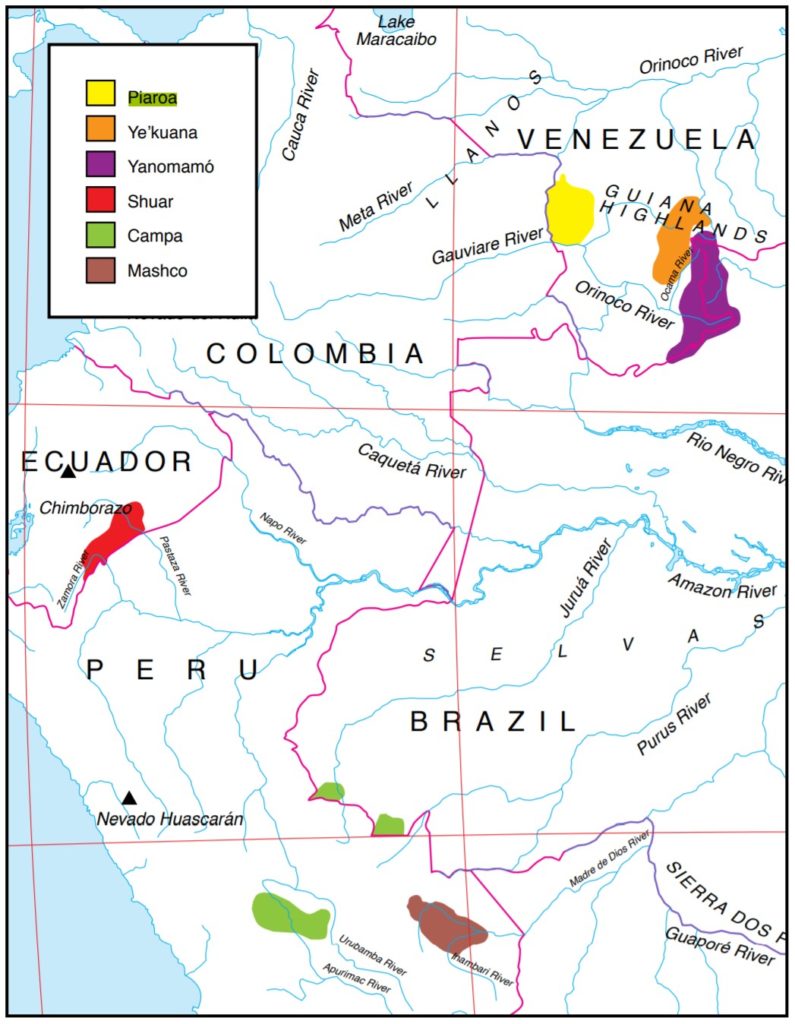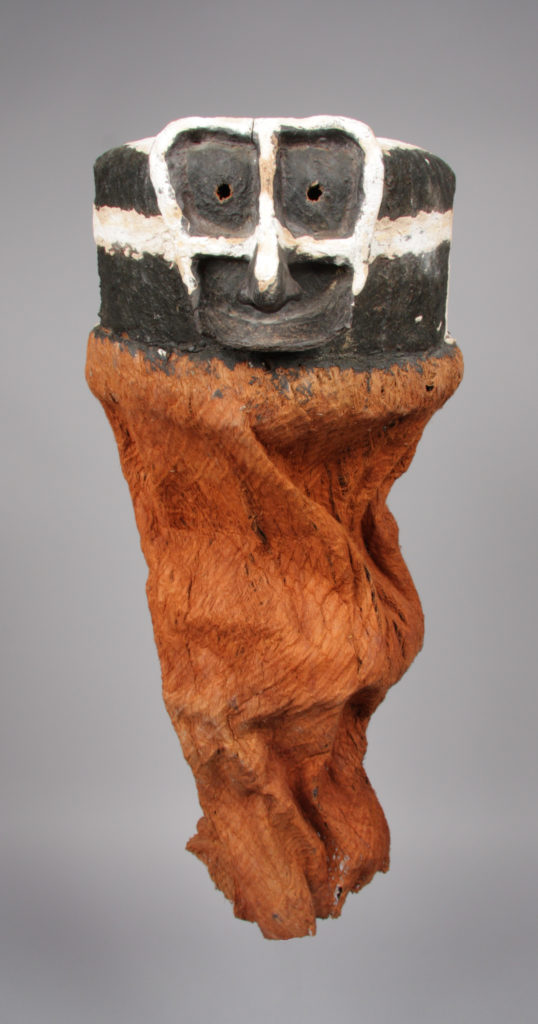The anthropology holdings of the Houston Museum of Natural Science include an extensive collection of ethnographic materials from South America, to be precise, from the Amazon and Orinoco River basins. These basins cover an area of 2.5 million square miles (or roughly twice the size of India). This hot and humid environment is home to many indigenous communities; among them are the Piaroa people.
The Piaroa refer to themselves as the De`áruwa people, or “the people of the forest.” The Piaroa population numbers approximately 14,500. Most of the Piaroa live in the Venezuelan states of Amazonas and Bolivar.

The origins of the tribe are unknown. With the arrival of the Europeans, in this case the Spaniards, the world of the ancestors of the Piaroa changed forever. Spain made persistent efforts to conquer and convert the indigenous populations to Christianity. The first missions were established in 1661. In 1684 the Jesuits founded seven new missions north of the Atures rapids, along the Orinoco River. By the middle of the 18th century that number had risen to twenty-five.
Hostilities between local tribes erupted when slave traders began to capture the Piaroa and other peaceful tribes, who had settled near the missions. They then sold them to Portuguese settlers living on the east coast of Brazil. The hostile conditions that followed reduced the number of missions to six by 1766. It must be assumed that the Piaroa, along with other peaceful tribes, suffered from all this turmoil that lasted into the 19th century.
It is not until the 19th century that our knowledge of the Piaroa improves with scientific expeditions crossing the region. Among the earliest of these was that of German naturalist, von Humboldt and his French colleague, Bonpland. They were followed by official Venezuelan government explorations, spearheaded by Michelena and Rojas in 1858. Their goal was to investigate the colonization efforts in the Orinoco region. Their success was largely due to the help given them by the Piaroa in crossing the Atures rapids. Other explorers who visited the Piaroa included Crevaux in 1880, and Koch-Grünberg in 1911-13. All those who encountered the Piaroa spoke of their timidity and peaceful ways, as well as their strong desire to avoid contact with white men out of fear of catching their diseases. In the 1960s and 1970s, noted anthropologists Johannes Wilbert, Lajos Boglár, Myron and Joanna Kaplan, contributed extensively to the main body of knowledge of the Piaroa.
Most of the Piaroa today have been assimilated into modern society. As this contact broadens, for example through Venezuelan government social programs, diseases are inadvertently introduced; large numbers of indigenous people suffer, and even die. This unravels the tight cultural fabric of native communities.
Efforts to convert people to Christianity have long been part of the landscape. With the arrival of the Europeans came the Catholic Church, and, starting in the 1970s, the US-based evangelical Christian New Tribes Mission started to aggressively proselytize among the Piaroa. These missions have caused further loss of native traditions, as Piaroa customs were either banned or radically altered.
A small section of Piaroa society, less than 2,000 by recent counts, has withdrawn to more remote parts of the jungle. Their homeland consists of rain forests, peppered with large rock formations, rapids and waterfalls. This makes it extremely difficult for outsiders to penetrate. Unfortunately, their numbers continue to dwindle.
The Piaroa live in a single communal house. This house is constructed next to the headwaters of a small stream, away from large rivers. Communal houses are located anywhere from a two-hour walk to a two-day walk from each other. The building’s frame consists of a central vertical pole and four supporting vertical posts connected by horizontal poles. A conical-shaped roof completes the structure. The entire frame is covered with palm frond thatching that extends from the roof ’s pinnacle to the ground. The size of the communal dwelling varies depending on the number of people in the community. It can house a nuclear family or as many as sixty people (the size of an extended family).
The Piaroa garden plots are planted close to the communal house. Each family owns two to four gardens. The fruits and vegetables from these gardens make up the bulk of their diet. Hunting, fishing, and gathering of fruits and nuts provide seasonally changing supplements to their food intake.
The Piaroa have two kinds of rites: those designed for the activities of everyday life and those designed to celebrate religious ceremonies held on an annual basis. The shaman officiates all rituals. Piaroa shamans are known throughout the region for possessing vast knowledge of the flora and fauna. Each Piaroa community has two shamans, known as Ruw’a. They hold political power and maintain the spiritual equilibrium of the group.
The shamans are always on guard against calamities such as disease. Illness can be caused by the violation of earth spirits, food taboos, or by a hunted animal-protector-spirit. Any of these can enter the hunter’s body and cause sickness.
The Piaroa believe that when animals and humans were first created, they all had the same shape. They mark the time when people and animals assumed their individual appearances; they do so with a specific ceremony, the Warime. This ceremony is the main social, cultural, and religious event in the Piaroa community. The Warime ceremony acts as a mechanism to pass the totality of the tribe’s knowledge from one generation to another. This includes information about collective tribal wisdom, mythology, religion, and ritual objects. This community celebration may last up to several months.
An important component of this celebration are masks, of which there are many. Typically, these masks are made by men ensconced in a large structure, built especially for this purpose. The men start by bringing the raw materials to build the masks into the hut. Then, as they consume manioc beer, body costumes and mask start to take shape.
It is important to note that as long as these gathered items remain as raw material in their natural setting, they have no particular significance. However, as soon as they are processed for the manufacture of ritual objects, the raw materials begin to assume symbolic and mystical meaning. As the construction of the masks progresses, the objects becomes more sacred.
Among the more important masks being made is the Redyo mask, the wild bee mask, which represents both the bee face and the tree trunk in which the bees make their hive. When the wearers of this mask dance, they represent the trees in the forest being moved by the wind. This melding of their ritual and physical world clearly epitomizes the Piaroa as the De’áruwa, or the “people of the forest.”

The museum’s holdings include 147 Piaroa objects, including a bee mask. One can appreciate the fragility as well as the artistry of these items. They have become more important in light of recent catastrophic losses of two museum collections in Brazil, caused by fires. We share items like these masks with the public by displaying them and by publishing catalogs that provide much needed context, like Beyond Bones.

